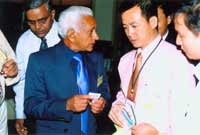China's
entry into 'pepper' world boosts Lankan meeting
Text and Pix by L.B. Senaratne
Kandy - The entry of China into the
International Pepper Community marks a period of improvement
for pepper. Though China opted to take an ' Observer
'status in the IPC, yet her entry was applauded at the
opening session of the IPC international conference
in Kandy last week.
China occupies sixth place in the
world market, according to Jlan Chunlin, Vice-Chairman
of the Department of Agriculture of Hainan Province,
China.
 |
| Picture shows a Chinese delegate
with one of the exhibitors at the conference hall |
He pointed out that the acreage consumption
per capita per year is less than 22 kg, lower than the
world level. In international trade, black pepper is
almost a half of what is produced. Chinese imports black
pepper around 1000 tons every year, but exports only
1000-2000 tons (mainly from Hainan). In recent years,
the main consuming and importing countries are almost
developed countries and China is not only an exporter
but also an importer.
Therefore, the market has an optimistic
view of pepper plantations in China, which occupies
10 per cent of the world market. Hainan is the most
suitable and concentrated area for pepper plantations.
He said that in 2005, the plantation
area in Hainan was more that 90 per cent of the national
total. The three counties - Qionghai, Wechang, Wanging
-- are the main pepper producing areas in Hainan.
At the Kandy meeting, it was announced
that there would be a change in the chairmanship of
IPC with Malaysia taking over the chair. General Manager
of the Pepper Marketing Board of Malaysia, Grunsim Ayom
is expected to be appointed to this post.
IPC’s annual report released
on September 6 points out that as the pepper industry
began its recovery from the low prices of the last few
years with declining production in most member countries,
IPC was in a position to play an effective part in the
development of the industry. It is an opportune time,
it says, to ensure that farm level development is on
a sustainable basis and does not continue to be subjected
to the savings and that are characteristic of most commodity
markets.
IPC now comprises six pepper producing
countries as full members -- Brazil, India, Indonesia,
Malaysia, Sri Lanka and Vietnam accounting for almost
90 per cent of global production.
World production of pepper in 2005
was estimated at 315,000 tons down by almost 14 per
cent from a peak of 364,500 tons in 2003.
Pepper production in Sri Lanka is
estimated at 13,000 metric tonnes in 2006 and the same
figure is expected in 2007. Domestic consumption for
2006 is an estimated 6,295 metrics but exports from
Sri Lanka have remained static at 7,000 metric tonnes.
Vietnam is the largest exporter of
pepper with 96,179 metric tones in 2005. IPC’s
present Executive Officer A. Abdulla from Malaysia who
retired after last week’session is to be replaced
by Dede Kuruma from Indonesia. .
|
